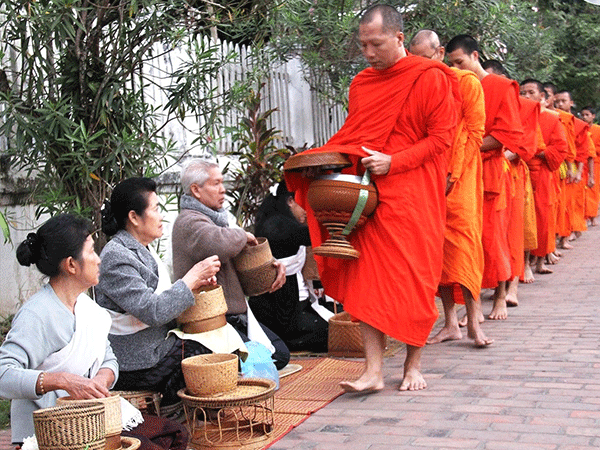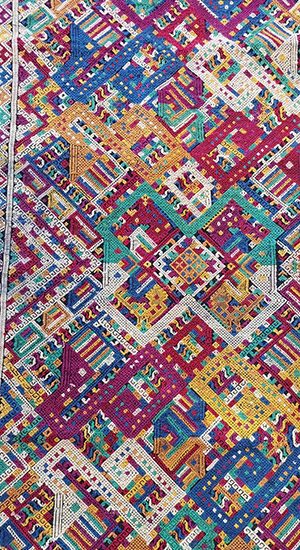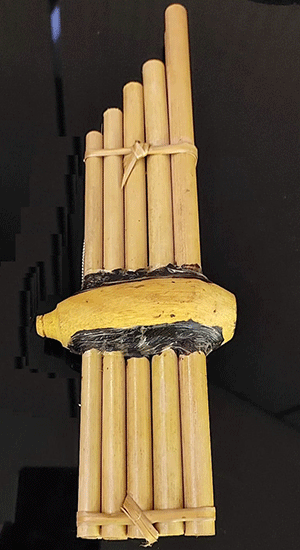 |
| Luang Prabang residents give alms in the early morning. Almsgiving is a daily cultural practice that remains alive throughout Laos. |
Lao culture: The soul of a nation at 50 years
This story marks the 70th anniversary of the establishment of the Lao People’s Revolutionary Party, the 50th anniversary of the founding of the Lao PDR, and the 105th birthday of President Kaysone Phomvihane this year.
Before dawn breaks over Luang Prabang, soft footsteps echo through the mist. Monks in saffron robes walk silently down narrow streets, their bowls held close, as the town’s residents kneel quietly along the roadside. The aroma of sticky rice rises into the cool air, blending with the faint scent of incense and frangipani blossoms. This daily ritual of almsgiving, calm and unhurried, captures the essence of Lao culture — a harmony between faith, humility, and community.
At the heart of Lao identity lies a profound sense of harmony. It is seen in the way communities gather to celebrate, in the respectful bow of greeting known as nop, and in the unspoken patience that characterises the Lao way of life. This spirit of harmony, deeply influenced by Theravada Buddhism, teaches people to live modestly, value kindness, and seek balance between material progress and inner peace.
Temples have long stood as the cultural and spiritual centers of the life of Lao people. There are more than 200 temples across the country, while Luang Prabang province alone has over 40, according to The History of Important Buddhist Stupas and Temples in Laos. Much of the nation’s fine culture has been preserved in Luang Prabang, where many traditional festivals are still organised in the old ways — just as they were in ancient times. Among these is the cherished custom of pouring water over Buddha images during Lao New Year to express respect and hope for blessings. The activities of Pi Mai Lao in Luang Prabang are ancient traditions that the new generation has preserved well from their forebears.
 |
 |
| A piece of traditional long skirt (sinh) that Lao women continue to weave and wear every day. |
The khaen, a bamboo mouth organ, captures the spirit of the nation. |
Beyond their religious importance, temples serve as schools, meeting places, and guardians of art and literature. The sound of monks chanting at dawn or the sight of novices walking barefoot to collect alms remain timeless scenes connecting past and present. Every morning, monks and novices leave their temples to receive offerings from local residents. In Luang Prabang, both residents and tourists sit quietly in long rows along the roadside before sunrise to offer alms — a powerful image of devotion and humility. Almsgiving has become a living tradition, passed from one generation to the next, and despite modernisation sweeping through towns and villages, these rituals continue to remind people of their shared moral foundation.
The 24th Lao Handicraft Festival, held recently at the Traditional Lao Silk Residence in Vientiane, also highlighted the nation’s rich cultural heritage — one that has been carefully preserved and promoted for generations. Artistic expression in Laos has always reflected the country’s gentle yet resilient spirit. Traditional weaving, for instance, is far more than a craft — it is a language of identity passed from mothers to daughters. The intricate patterns of the traditional long skirt (Sinh) tell stories of local beliefs, natural beauty, and ancestral wisdom. Lao women wear the sinh in a variety of patterns that reflect the country’s many ethnic groups, each with its own distinctive style. The famous Naga motif has even been recognised by UNESCO for its cultural significance. Across the country, women continue to weave on wooden looms, keeping alive centuries-old techniques that define the unique aesthetic of Laos.
Similarly, Lao music — with its distinctive khaen, a bamboo mouth organ — captures the spirit of the nation. Its haunting melodies accompany festivals, folk tales, and family gatherings, serving both as entertainment and storytelling. In recent years, young artists have begun blending the sound of the khaen with modern music genres such as pop and hip-hop, creating a new cultural dialogue that bridges generations. This creative evolution shows that tradition and modernity can coexist harmoniously, adding new layers to the national identity.
Culture in Laos is not confined to temples or festivals; it is woven into daily life. The aroma of sticky rice steaming in bamboo baskets each morning, the act of sharing food with neighbors, and the deep respect for elders all reveal the quiet beauty of Lao customs. In rural villages, evening gatherings often take place under stilted houses, where families share stories and laughter over simple meals — a scene that perfectly captures the warmth and humility of Lao life.
Architecture, too, reflects the Lao connection to nature and community. Traditional wooden houses, raised on stilts, are designed for both practicality and harmony with the environment. They provide cool living spaces during the hot season and protection during floods. In urban areas, while modern buildings rise rapidly, there is growing awareness of the need to preserve traditional architectural styles that embody the country’s cultural wisdom and environmental balance.
The 50th anniversary of the Lao PDR is a time of reflection and gratitude — for peace, stability, and the enduring beauty of a culture that continues to guide the nation. Across towns and villages, from the gilded temples of Vientiane to the quiet mountain valleys of Phongsaly province, Lao culture lives on in every smile, every song, and every shared meal. It remains the heartbeat of the nation and the foundation of its people’s way of life.
In celebrating this milestone, Laos honors not just its political achievements but also the gentle, unbroken thread of cultural identity that binds its people together. At 50, the roots of the Lao nation remain deep and strong — nurturing a people proud of their past and confident in their future, united by a culture that continues to shine as the soul of the nation.
By Phon Thikeo
(Latest Update October 29, 2025)
|




